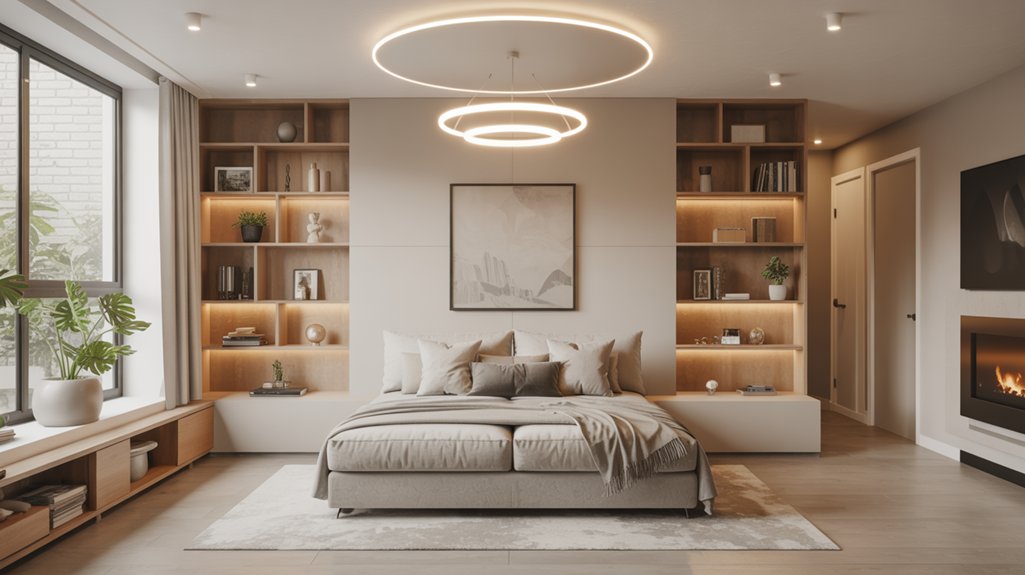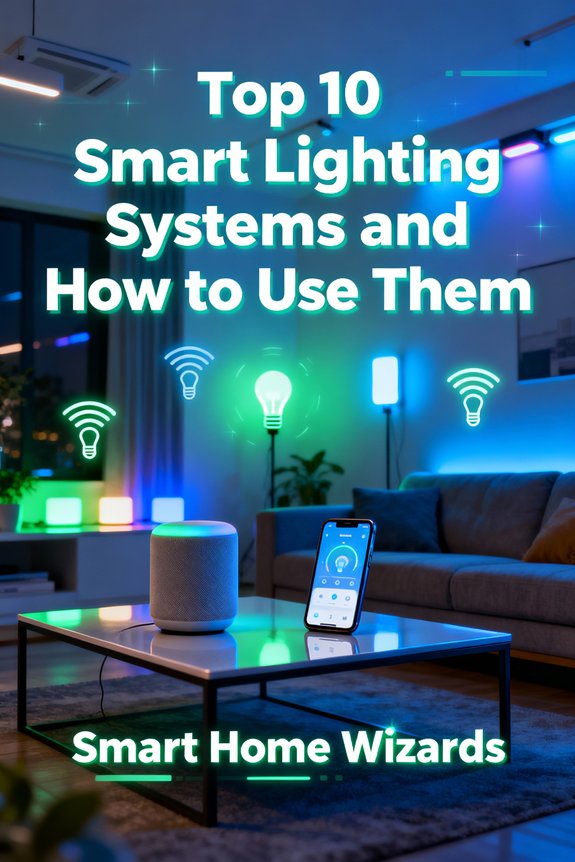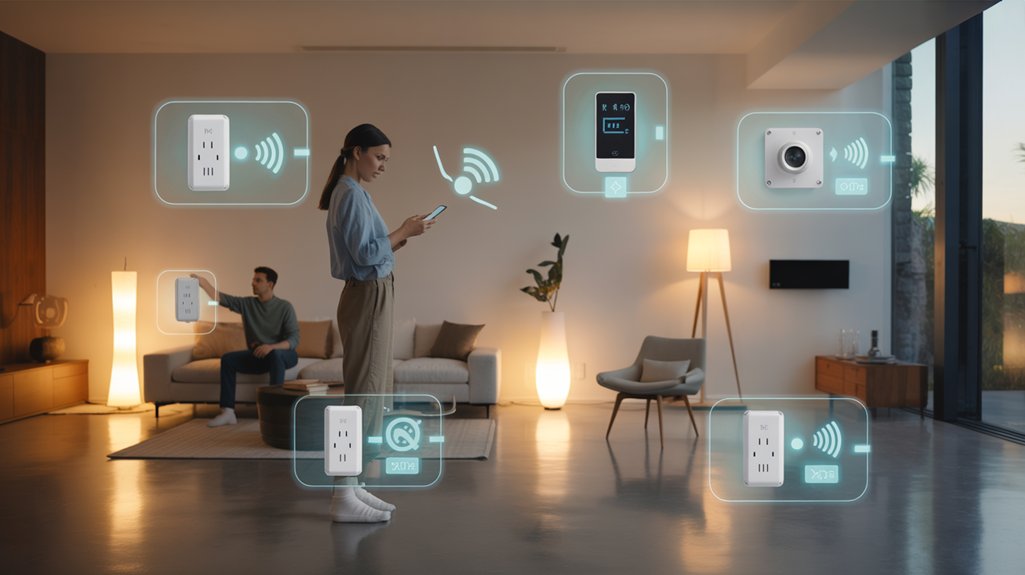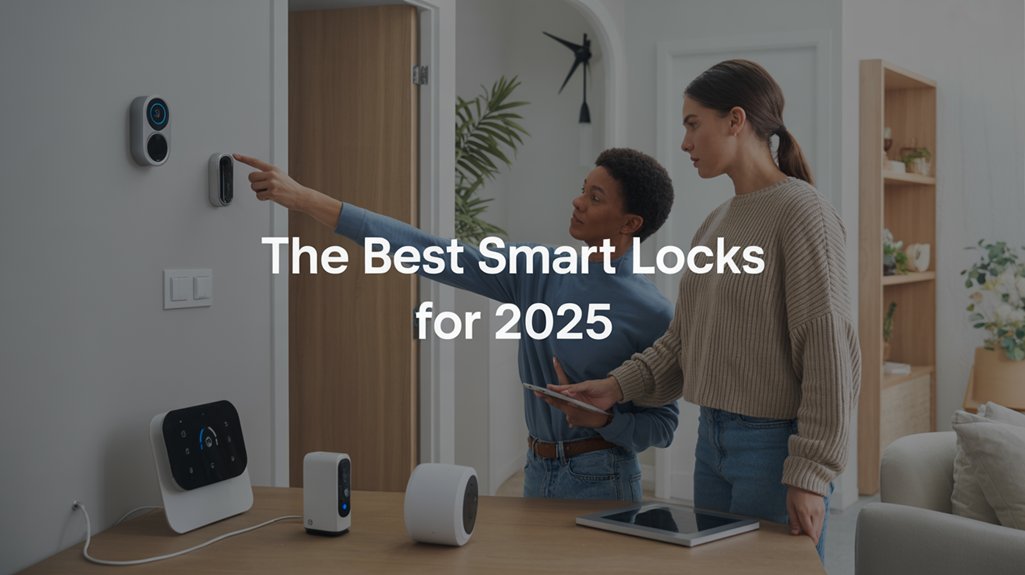You’ll find Philips Hue leads the market with its Zigbee architecture supporting 50+ devices per bridge, while LIFX eliminates hub requirements through direct Wi-Fi connectivity at 1100 lumens. Nanoleaf’s modular panels use Thread protocol for creative installations, and Wyze offers budget-conscious RGB control. TP-Link Kasa and GE Cync provide reliable Wi-Fi implementations, while Lutron Caséta’s Clear Connect RF delivers professional-grade dimming. Govee’s addressable LED strips feature camera-based color calibration, and Yeelight integrates smoothly with Xiaomi’s ecosystem. Each system’s setup, API capabilities, and automation features deserve closer examination.
Key Takeaways
- Philips Hue uses Zigbee protocol with a bridge, supporting 50+ devices, offering 16 million colors and extensive smart home platform compatibility.
- LIFX operates on WiFi without hubs, delivers 1100 lumens brightness, and fits standard sockets for straightforward installation and control.
- Nanoleaf features modular panels with Thread or Wi-Fi connectivity, allowing creative wall arrangements and independent addressability per module.
- Govee LED Strips provide addressable RGB segments up to 32.8 feet, camera-based color matching, and gradient effects for ambient lighting.
- Lutron Caséta requires neutral wire for dimmer switches, uses Clear Connect RF protocol, and offers professional-grade reliability with voice assistant integration.
Philips Hue: The Gold Standard in Smart Lighting
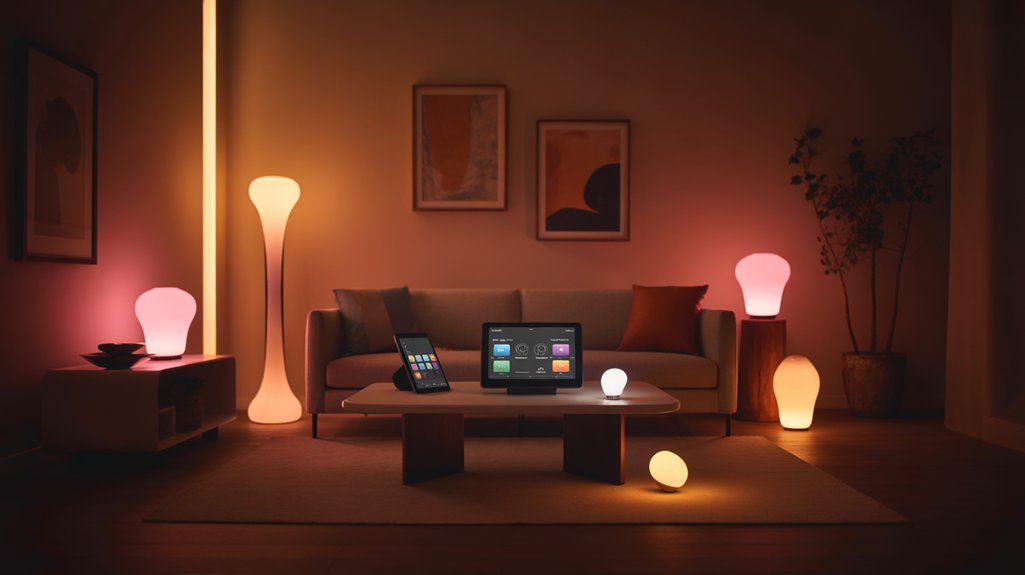
Philips Hue dominates the smart lighting ecosystem through its mature Zigbee-based architecture and extensive API support. You’ll utilize its RESTful API for custom integrations, enabling programmatic control across your entire lighting infrastructure. The system supports 16 million colors per bulb with precise dimming curves and scene changes.
Philips Hue features include Entertainment API for sub-100ms sync with media content, Matter protocol compatibility, and strong third-party integration through HomeKit, Alexa, and Google Assistant. You can implement gradient lightstrips, outdoor fixtures, and smart switches within a single mesh network supporting 50+ devices per bridge.
Philips Hue delivers sub-100ms Entertainment API synchronization, Matter compatibility, and seamless third-party integration across extensive ecosystem deployments.
Philips Hue pricing positions starter kits at $200-250, individual color bulbs at $50, and white ambiance options at $25. Enterprise deployments benefit from bulk licensing and commercial-grade fixtures.
The platform’s SDK enables custom application development, making it ideal for automation workflows requiring millisecond-precision timing and complex conditional logic across multiple zones. The system excels at creating mood lighting that adapts to various activities and atmospheres throughout your home.
LIFX: Brilliant Colors Without the Hub
LIFX operates exclusively over WiFi, eliminating bridge hardware while delivering superior brightness at 1100 lumens compared to Hue’s 800. You’ll access 16 million LIFX color options through direct network integration, bypassing proprietary hubs entirely.
| Feature | Specification |
|---|---|
| Connectivity | 2.4/5GHz WiFi |
| Color Temperature | 2500K-9000K |
| RGB Accuracy | 16-bit per channel |
| API Access | HTTP RESTful |
| Power Draw | 11W maximum |
LIFX app features include scheduling automation, scene creation, and third-party integrations with HomeKit, Alexa, and Google Assistant. You’ll implement advanced controls through HTTP API endpoints, enabling custom scripts and enterprise deployments. The polychrome technology delivers saturated reds and deep blues that outperform competing RGB systems.
Install bulbs directly into standard E26/E27 sockets—no gateway required. You’ll configure each unit through the mobile application, establishing direct cloud connectivity for remote access and firmware updates. When compared to the Ikea smart lights versus Philips Hue debate, LIFX provides premium features that justify the investment for users prioritizing color accuracy and advanced functionality.
Nanoleaf: Artistic Panels That Transform Your Walls
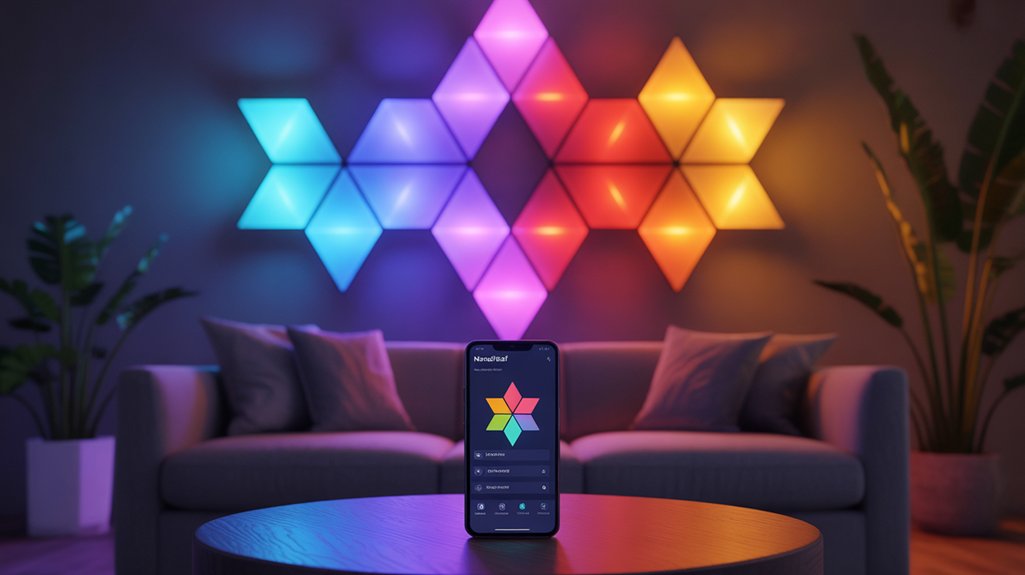
- Layout Configuration – Position your controller panel first, then extend adjacent panels using Linker connectors to establish power distribution across your array.
- Network Integration – Connect via Thread protocol or Wi-Fi to enable HomeKit, Google Assistant, and Alexa control architectures.
- Scene Programming – Deploy the mobile application to engineer custom color palettes, animation sequences, and reactivity parameters that respond to audio inputs.
- Automation Rules – Configure scheduling protocols and trigger-based activation through IFTTT integration.
Nanoleaf creativity extends beyond static lighting; you’ll orchestrate lively compositions that shift throughout operational cycles.
Transform your environment with dynamic lighting sequences that evolve continuously, creating an immersive atmospheric experience beyond conventional illumination systems.
Nanoleaf customization enables you to engineer installations ranging from minimalist accent arrays to thorough wall-spanning deployments.
Each hexagonal or triangular module delivers independent addressability for granular control over your lighting ecosystem.
Wyze Bulbs: Budget-Friendly Smart Lighting That Delivers
You’ll find Wyze Bulbs deploy through a straightforward provisioning workflow that utilizes 2.4GHz Wi-Fi connectivity and the Wyze mobile application for device pairing.
The installation requires standard E26 socket compatibility, eliminating the need for additional hubs or gateways in your smart home infrastructure.
These bulbs integrate core functionality including RGB color adjustment, tunable white temperature (2700K-6500K), scheduling automation, and voice control through Alexa and Google Assistant protocols.
Setup and Installation Process
Getting Wyze bulbs operational requires minimal technical expertise, though understanding the setup workflow guarantees a smooth deployment.
You’ll utilize the Wyze app’s efficient interface to establish wireless connectivity between your bulbs and network infrastructure.
Installation Protocol:
- Physical Installation – Screw bulbs into standard E26/E27 sockets and power them on. The bulb enters pairing mode automatically, indicated by rapid pulsing.
- App Configuration – Launch the Wyze app, select “Add Device,” then choose “Wyze Bulb” from the product catalog.
- Network Integration – Connect to your 2.4GHz Wi-Fi network (5GHz unsupported). Input credentials and allow 30-60 seconds for authentication.
- Firmware Updates – Execute any available firmware patches immediately post-installation to maintain peak performance and security hardening.
Your bulbs now respond to voice commands, scheduling protocols, and automation rules.
Key Features and Functions
Wyze bulbs deliver substantial functionality despite their competitive price point, positioning them as viable alternatives to premium smart lighting ecosystems. You’ll access full RGB spectrum control, tunable white temperatures (2700K-6500K), and dimming capabilities through the native application. The platform supports scheduling automation, voice integration with Alexa and Google Assistant, and group control protocols for multi-bulb deployments.
| Feature Category | Specification | Power Consumption |
|---|---|---|
| Color Temperature | 2700K-6500K | 9W maximum |
| Brightness Output | 800-1100 lumens | Variable wattage |
| Connectivity | Wi-Fi 2.4GHz | Standby: <0.5W |
Smart energy monitoring tracks usage patterns, while user customization extends to scene creation and vacation modes. You’ll implement away-from-home controls and integrate bulbs into existing smart home routines without requiring dedicated hubs.
TP-Link Kasa: Reliable Performance at an Affordable Price
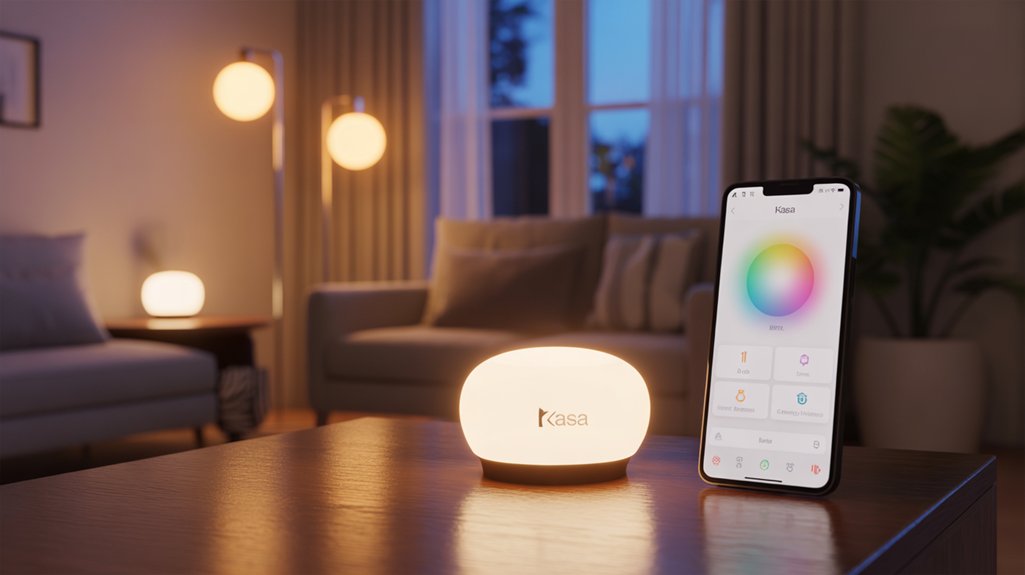
TP-Link Kasa’s smart bulbs utilize a Wi-Fi-based architecture that eliminates the need for additional hubs, enabling direct integration with your existing 2.4GHz network infrastructure.
The deployment process requires pairing each bulb through the Kasa Smart app, configuring network credentials, and assigning devices to rooms for efficient management.
You’ll achieve smooth voice control by linking your Kasa account to Amazon Alexa, Google Assistant, or Apple HomeKit platforms through their respective companion applications.
Key Features and Setup
When you configure the Kasa system, you’ll find its implementation centers on three core capabilities: per-bulb dimming control (1%-100%), customizable scheduling through the mobile application, and integration with Amazon Alexa, Google Assistant, and Samsung SmartThings protocols.
The deployment process requires minimal technical expertise:
- Network Configuration: Connect bulbs to your 2.4GHz Wi-Fi network through the Kasa app’s discovery protocol.
- Scene Programming: Define lighting presets with specific brightness levels and color temperatures for automated execution.
- Schedule Optimization: Utilize smart lighting benefits through automated on/off cycles, delivering energy savings up to 80% versus traditional incandescent fixtures.
- Voice Command Mapping: Establish control hierarchies within your chosen ecosystem for hands-free operation.
You’ll achieve full system operability within 15 minutes per device.
Voice Assistant Compatibility
Since the Kasa system operates through cloud-based API integrations, you’ll experience native compatibility across Amazon Alexa, Google Assistant, and Samsung SmartThings platforms without requiring additional bridge hardware.
You’ll execute voice control commands with sub-second latency, leveraging OAuth 2.0 authentication protocols that maintain persistent connections to your smart home ecosystem.
The system supports advanced voice routines, enabling you to chain multiple lighting actions through conditional triggers.
You’ll configure custom wake words and command structures that bypass typical assistant limitations. Kasa’s API documentation provides webhook access for power users who demand deeper integration capabilities.
Deploy scene activation through voice control by mapping specific phrases to preset configurations.
You’ll achieve granular dimming control through percentage-based commands, eliminating imprecise brightness adjustments that plague competing platforms.
Sengled: Energy-Efficient Smart Bulbs With Built-In Speakers
Sengled’s Pulse series integrates full-range JBL speakers directly into LED bulb housings, delivering synchronized audio and illumination through a single E26/E27 socket installation.
Sengled Pulse merges JBL audio technology with LED lighting, enabling single-socket installations that eliminate conventional speaker wiring requirements.
You’ll control Sengled speaker functionality through Bluetooth connectivity, enabling multi-room audio distribution without additional wiring infrastructure. The system achieves Sengled energy savings by consuming only 13 watts while producing 800 lumens and delivering satellite speaker output.
Implementation specifications:
- Master-satellite configuration: Install one master bulb (Bluetooth receiver) with up to seven satellite bulbs for amplified coverage across 300+ square feet.
- Dimming integration: Pair with standard dimmer switches to control brightness independently from audio levels.
- App-based equalization: Access the Sengled Pulse app for bass/treble adjustment and firmware updates.
- Power cycling protocols: Utilize three rapid on-off sequences to reset Bluetooth pairing when connection issues occur.
You’ll enhance system performance by positioning master bulbs centrally within open-plan spaces, avoiding enclosed fixtures that compromise acoustic dispersion.
GE Cync: Seamless Integration With Google Home
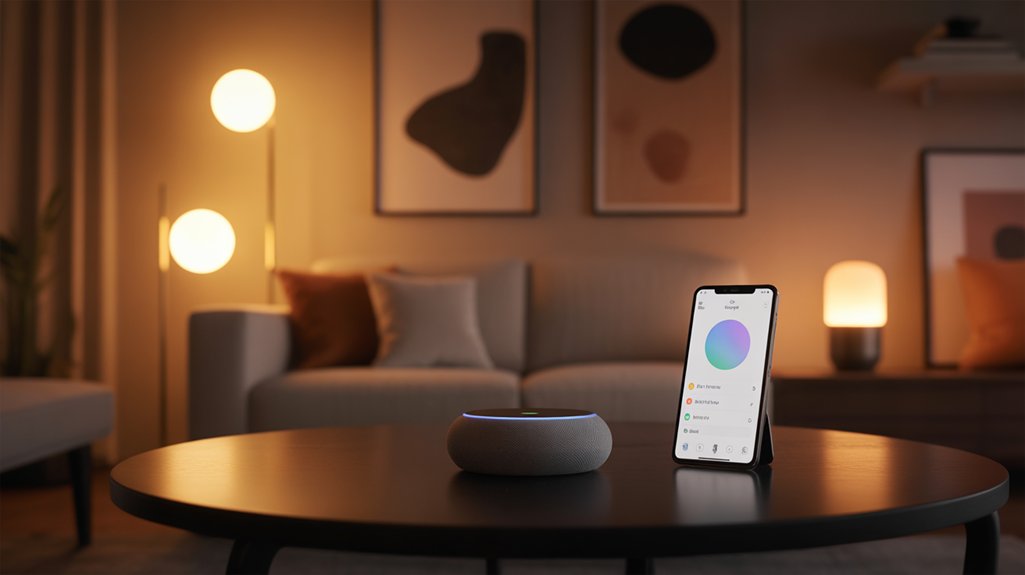
GE Cync’s direct-connect architecture eliminates third-party hub requirements by embedding Google Assistant protocols into its Wi-Fi-enabled bulb firmware, enabling voice control immediately after network authentication. You’ll configure devices through the Cync app, which provisions credentials and establishes persistent connections to Google’s cloud infrastructure.
The integration delivers command execution latency under 500ms for standard operations:
| Command Type | Execution Method |
|---|---|
| Voice Control | Google Assistant native API |
| Scheduling | Cloud-based automation engine |
| Scene Activation | Local network broadcast |
You’ll utilize Google Assistant’s natural language processing for complex lighting scenarios without programming custom routines. The system supports RGB+CCT tuning across 16 million color combinations and 2000K-7000K temperature ranges. Group controls scale to 50 bulbs per network segment, while geofencing triggers automate state changes based on device proximity. Power users gain access to RESTful APIs through Google Home’s developer console for advanced scripting and third-party service integration.
Lutron Caséta: Professional-Grade Dimming and Control
Lutron Caséta operates on a proprietary Clear Connect RF protocol, delivering reliable communication between the Smart Bridge hub and wireless dimmers without relying on Wi-Fi mesh networks.
You’ll need to wire Caséta dimmer switches directly into your electrical boxes, replacing existing switches while the Smart Bridge connects to your router via Ethernet for cloud access and third-party integrations.
The system supports IFTTT, Amazon Alexa, Google Assistant, and HomeKit protocols, enabling you to configure complex automation routines that trigger based on occupancy sensors, geofencing, or time-based schedules.
Installation and Setup Process
While Lutron Caséta’s professional-grade capabilities deliver superior dimming performance, the system’s installation complexity sits somewhere between basic smart bulbs and whole-home wired solutions.
You’ll need to replace existing switches with Caséta dimmers, requiring neutral wire compatibility and basic electrical knowledge.
Implementation Steps:
- Mount the Smart Bridge – Position the hub centrally for ideal wireless connectivity throughout your installation footprint.
- Install Dimmer Switches – Remove existing switches, verify neutral wire presence, and connect Caséta dimmers following load specifications.
- Configure Pico Remotes – Program auxiliary controls for three-way configurations or scene activation without additional wiring runs.
- Commission the System – Complete app navigation setup, assign rooms, create lighting scenes, and integrate with third-party platforms like HomeKit or Alexa.
Professional installers typically complete whole-home deployments within 4-6 hours.
Compatible Devices and Integrations
Once your Caséta infrastructure is operational, the system’s open API architecture releases extensive third-party compatibility across major smart home ecosystems. You’ll utilize native smart home integration protocols including HomeKit, Alexa, and Google Assistant without requiring additional bridges.
| Platform | Protocol | Control Method |
|---|---|---|
| Apple HomeKit | Thread/Matter | Siri voice, Home app automation |
| Amazon Alexa | Cloud API | Voice commands, routines, scenes |
| Google Home | Cloud API | Assistant voice, app control |
Device compatibility extends beyond voice assistants. You can integrate Pico remotes with Sonos speakers, sync lighting with Ring doorbells, and coordinate with Serena shades. The Ra3 processor enables advanced scene programming across 100+ devices. Professional installers appreciate the LEAP protocol for custom programming through third-party control systems like Control4 and Crestron.
Advanced Scheduling and Scenes
Beyond basic on/off commands, Caséta’s scheduling engine utilizes astronomic timeclock algorithms that adjust daily based on your geographic coordinates and seasonal sunrise/sunset variations.
You’ll utilize smart routines that automatically compensate for daylight saving changes without manual reconfiguration.
Advanced scene deployment includes:
- Multi-room presets – Program granular dimming levels across 50+ zones simultaneously with single activation commands
- Conditional triggers – Stack multiple parameters including occupancy sensors, geofencing radius, and time-of-day constraints for personalized automation
- Load-specific ramping rates – Configure individual fade curves (0.5-60 seconds) tailored for LED compatibility and transformer characteristics
- Priority override protocols – Establish hierarchical control layers that supersede scheduled events during security alerts or emergency conditions
You’ll execute these configurations through Lutron’s integration protocol for enterprise-grade reliability.
Govee: Dynamic LED Strips for Ambient Lighting
Govee’s LED strip systems utilize addressable RGB+IC architecture to deliver per-segment color control across strips ranging from 16.4 to 32.8 feet.
You’ll configure individual zones through the Govee app, enabling gradient effects and reactive animations that standard single-color strips can’t achieve.
The Govee color calibration system employs a camera-based setup for TV backlighting applications, analyzing on-screen content to synchronize ambient lighting in real-time.
You’ll mount the camera above your display, run the calibration sequence, and enable the DreamView feature for content-reactive illumination.
Integration capabilities include Matter protocol support on select models, allowing cross-platform control through Apple Home, Google Home, or Amazon Alexa.
You’ll implement IFTTT triggers for advanced automation scenarios beyond native app functionality.
Power injection becomes critical for installations exceeding 16 feet—you’ll need to inject additional power at the strip’s midpoint to maintain consistent brightness and prevent voltage drop across addressable segments.
Yeelight: Xiaomi’s Versatile Smart Lighting Ecosystem
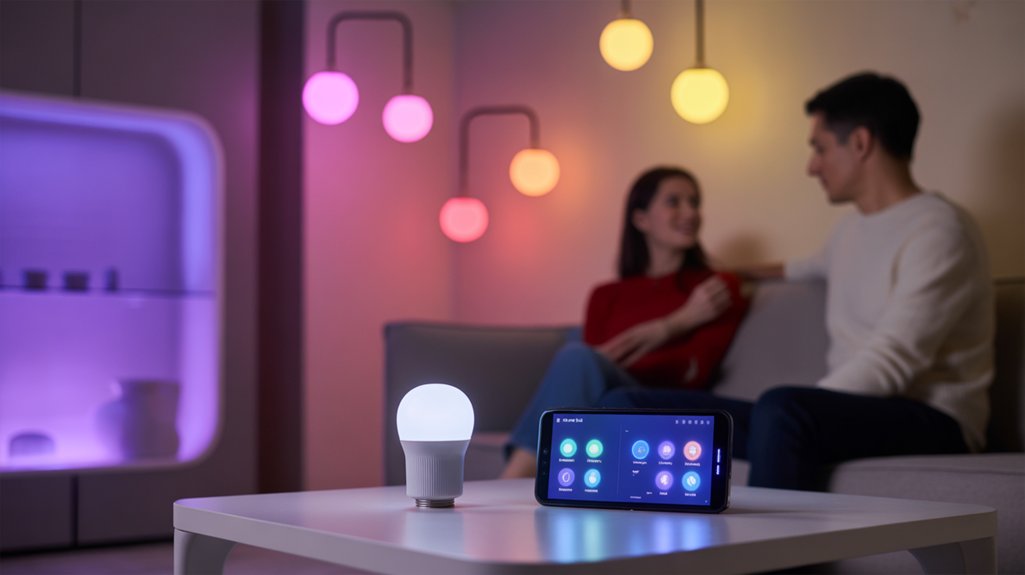
Yeelight’s product lineup spans seven categories—bulbs, tubes, panels, strips, ceiling fixtures, floor lamps, and ambient lighting—all operating within Xiaomi’s Mi Home ecosystem.
You’ll gain complete protocol control through both proprietary and Matter compatibility, enabling cross-platform deployment at scale.
Core Yeelight features for power users:
- LAN Control Protocol – Execute commands via local network API without cloud dependency, achieving sub-100ms response times for automation sequences.
- YLKG Integration – Deploy wireless controllers supporting scene triggers, dimming curves, and multi-device grouping through proprietary mesh networking.
- Razer Chroma Sync – Synchronize RGB output with system events, creating immersive environmental responses for gaming setups.
- Music Mode Processing – Implement real-time audio analysis with customizable frequency ranges and sensitivity thresholds for reactive lighting.
Yeelight integration extends beyond basic HomeKit and Alexa support.
You’ll access IFTTT webhooks, Home Assistant native components, and OpenAPI documentation for custom middleware development.
Their RGBWW diodes deliver 16 million color combinations with 1% dimming precision.
Frequently Asked Questions
Do Smart Bulbs Work During Internet Outages or Power Failures?
Smart bulbs won’t function during power failures unless you’ve implemented backup power solutions like UPS systems or generators.
However, during internet outages, you’ll retain local control capabilities through Bluetooth or Zigbee protocols, depending on your system’s architecture.
To enhance operational resilience, you should deploy hub-based systems with local processing rather than cloud-dependent configurations.
Consider integrating battery-backup infrastructure for critical lighting circuits, ensuring you maintain illumination authority even when grid power or network connectivity fails.
Can I Use Multiple Smart Lighting Brands Together in One Home?
Yes, you can deploy multiple smart lighting brands simultaneously, though brand compatibility varies greatly.
You’ll achieve the best ecosystem integration through platform aggregators like Home Assistant or Hubitat, which unify disparate protocols.
Alternatively, utilize universal standards—Zigbee, Z-Wave, or Matter—enabling cross-brand communication.
Voice assistants (Alexa, Google Home) also bridge manufacturer silos effectively.
However, you’ll sacrifice some native features when mixing ecosystems.
For maximum control flexibility, implement a hub-based architecture supporting multiple protocols simultaneously.
How Much Do Smart Bulbs Increase My Monthly Electricity Bill?
Smart bulbs actually *decrease* your electricity costs.
You’ll achieve smart bulb savings of 75-80% compared to incandescent bulbs, as LED-based smart lighting consumes 8-10 watts versus 60 watts. The energy efficiency gains translate to approximately $3-7 monthly reduction per bulb at standard usage rates.
When you utilize automation protocols—dimming schedules, occupancy detection, and lumen optimization—you’ll enhance ROI through reduced consumption while maintaining complete environmental control over your lighting infrastructure.
Will Smart Bulbs Work With My Existing Dimmer Switches and Fixtures?
Most smart bulbs won’t work with traditional dimmer switches due to compatibility issues—you’ll risk flickering, buzzing, or complete failure.
Leading-edge and trailing-edge dimmer switch types both conflict with smart bulbs’ internal circuitry. You must remove existing dimmers and install standard on/off switches, then control brightness through your smart bulb’s app or hub.
Alternatively, deploy smart switches that explicitly support smart bulbs, giving you centralized control over your intelligent lighting infrastructure.
What Happens to My Smart Lights if the Company Discontinues Support?
Like a ship without a captain, your smart lights won’t sink immediately—they’ll drift into basic functionality.
You’ll lose cloud features, app updates, and integration capabilities, though local control often persists.
Smart light longevity depends on your migration strategy: evaluate support alternatives like Home Assistant or Hubitat for protocol-agnostic control.
You’re safeguarding your investment by prioritizing systems using Zigbee, Z-Wave, or Matter—open standards that guarantee continued operation beyond manufacturer lifecycles, maintaining your autonomous smart infrastructure.
Conclusion
Like Prometheus bringing fire to humanity, you’ve now accessed illumination’s cutting edge. Deploy these IoT-enabled fixtures using mesh protocols (Zigbee, Thread, or Wi-Fi) based on your network topology. Start with core zones—integrate voice assistants, configure automation routines through your platform’s API, then scale room-by-room. Remember: proper implementation trumps premium hardware. Whether you’re commissioning Philips’ proven ecosystem or Govee’s addressable RGB strips, you’ll convert static circuits into responsive, adaptive environments that react to your lifestyle’s cadence.

